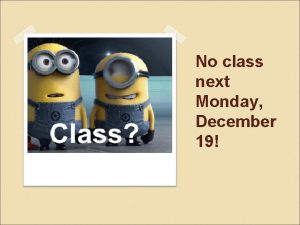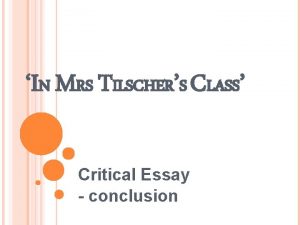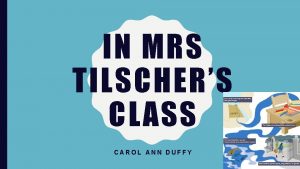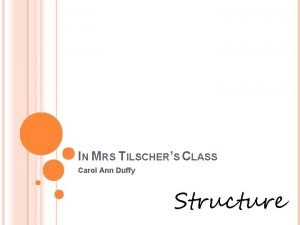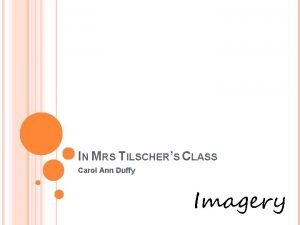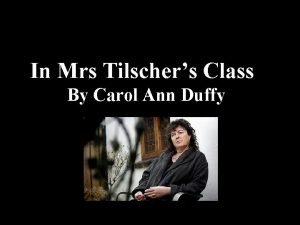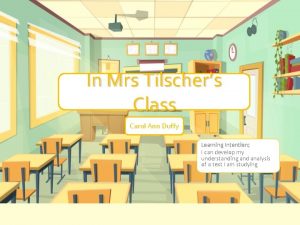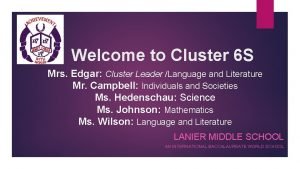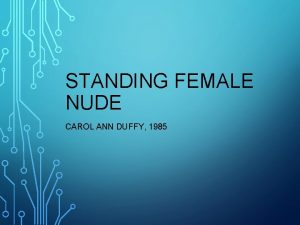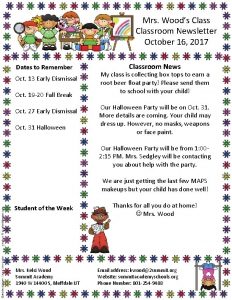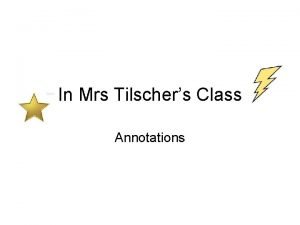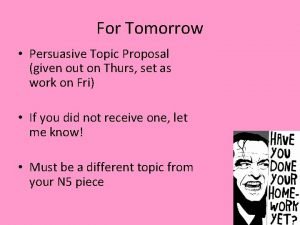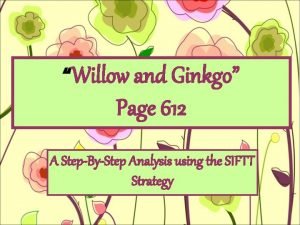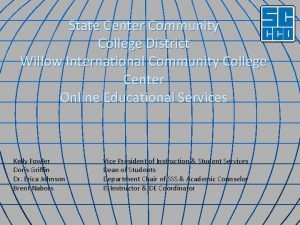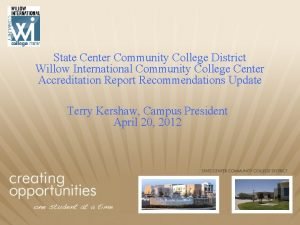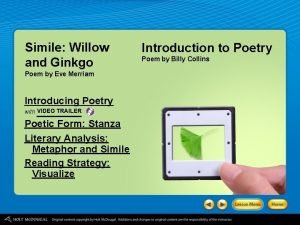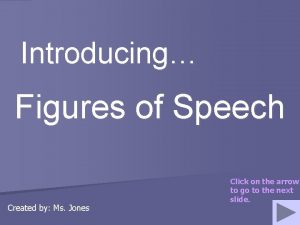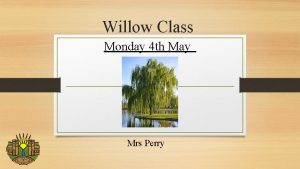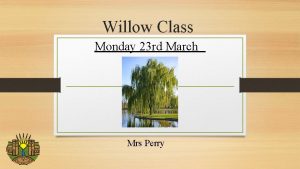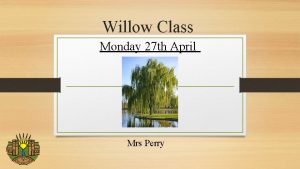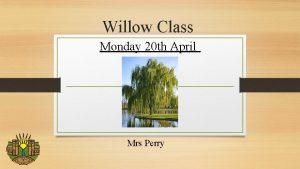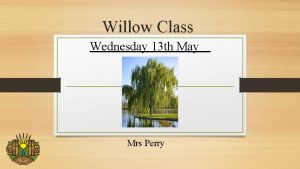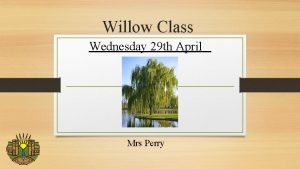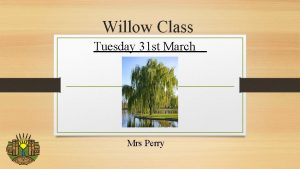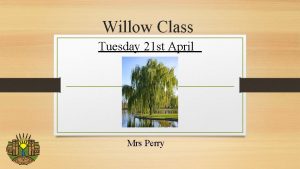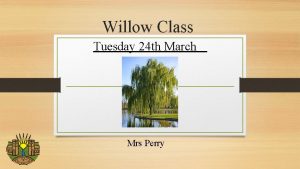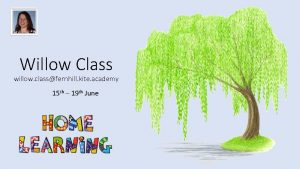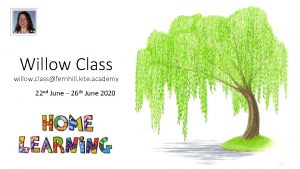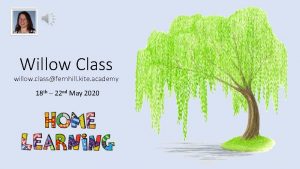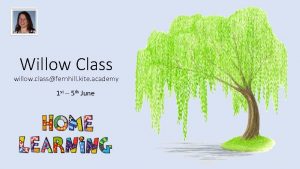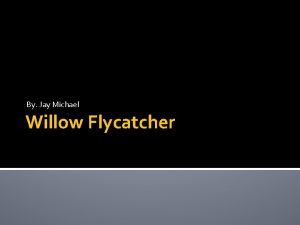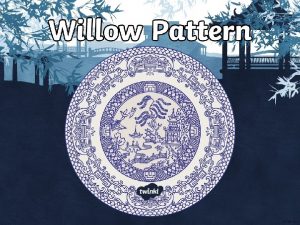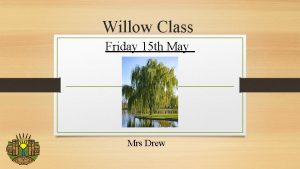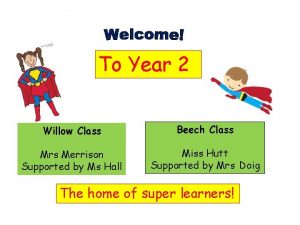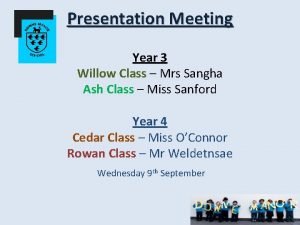Willow Class Monday 18 th May Mrs Perry





















- Slides: 21

Willow Class Monday 18 th May Mrs Perry

Monday 18 th May Today’s lessons will be: 1. Spellings 2. English (Grammar) 3. Maths 4. Handwriting 5. Art Good morning Willow friends! I hope you have had a good weekend! Here is your work for today.

Year 2 Spellings Year 3 Spellings Use look, cover, write, check • Look, cover, write, check to practise learning these spellings. • Practise these spellings in your book. word work immature immortal worm world impolite impatient worth worst dropped always inactive impossible others watching incomplete informal incredible Look, cover, write and check.

Year 2 and 3 Reading Read your school reading book (or your own reading book for free readers) for at least 15 minutes.

English Read through your informal letter from Friday 15 th May. Did you manage to follow all the success criteria? If so, well done! • Year 2 • Start with Dear ………a nd use a chatty and informal style. • Accurate use of full stops, capital letters and exclamation marks. • Correct tense – remember you are writing about what has happened so it will be in the past tense. • Interesting vocabulary to add detail to your story. For example – You’ll never guess what happened to me yesterday! I went on the most amazing journey. • Neat handwriting with some joins. Year 3 • Start with Dear……. and use a chatty and informal style. • Use paragraphs to help you to organise your letter. • Use a range of punctuation accurately. • Correct tense – remember you are writing about what has happened so it will be in the past tense. • Interesting vocabulary to add detail to your story. • For example – Yesterday was one of the most exhilarating days of my life! I was absolutely terrified when we zoomed off through the clouds. • Neat handwriting with some joins.

Year 2 English Monday 18 th May LO: To use subordinating conjunctions. It is important to use the right conjunction so that the sentence makes sense. • Conjunctions are words that we use to join sentences or clauses together. For example, ‘and’, ‘because’, ‘or’, ‘when’. • Subordinating conjunctions join two sentences or clauses – the main clause (the main thing the sentences is about) and the subordinate clause (which gives extra information). • Go to the website below and watch the video about subordinating conjunctions. • https: // www. bbc. co. uk/bitesize/topics/zwwp 8 mn/articles/zqk 37 p 3 • TASK 1 Complete the short activity underneath the video. . MORE TASKS on next slide…

Monday 18 th May Year 2 English LO: To use subordinating conjunctions. TASK 2 Complete the sentences using the most appropriate conjunction. Use one of these coordinating conjunctions: 1. 2. 3. 4. 5. 6. 7. 8. because when if The icicles are dripping ______ it is getting warmer. Bob likes walking ______ he is on holiday. Dylan could not play his game ______ he forgot the batteries. The children would be rewarded ______ they followed the rules. Jacob wanted a dog for a pet ______ he loved dogs You can borrow my pencil . _____ yours breaks. Sarah will buy a doll _____ she has saved up enough money. Michael won a prize _____ his ticket was picked in the raffle. TASK 3 Write your own sentences – one for each of the conjunctions. Remember your correct punctuation!

Year 3 English Monday 18 th May LO: To use there, their and they’re. Look carefully at how each word is spelt. • The words ‘there’, ‘their’ and ‘they’re’ are homophones of each other. They sound the same but are spelt differently and have different meanings. • ‘there’ = a place or location • ‘their’ = something belongs to someone • ‘they’re’ = a contraction of ‘they are’ Watch the video in this BBC Bitesize lesson to find out more: • https: // www. bbc. co. uk/bitesize/articles/zk 2 c 92 p • TASK ONE Complete the Activities 1 and 2 below the videos. TASK TWO on next slide…

Monday 18 th May Year 3 English LO: To use there, their and they’re. Check the meaning carefully. TASK 2 • Write out the sentences and complete with ‘there’, ‘their’ or ‘they’re’. 1. Put the book over ________ on the shelf. 2. _________ bus was running late. 3. The cold wind made _______ teeth chatter. 4. Could they be in _________ ? 5. Blue Smarties are the best, ________ my favourites. 6. Ava and Lucas put _________ hands up at the same time. 7. Are you sure ________ not real? 8. The new teacher got ________ books in a muddle. 9. I went __________ last summer too! 10. Is __________ a doctor anywhere near? Answers will be on tomorrow’s slides. TASK 3 Write sentences of your own using there, their and they’re correctly.

Year 2 Maths How did you get on? Mental Arithmetic answers for Friday 1 stown Maywork. Answers from Friday’s work. Mark your 1. ) 6+3+7= 16 2. ) 30+60= 90 3. ) 20 -13= 7 4. ) 11 x 5= 55 5. ) 10 x 10= 100 6. ) 56 =63 -7 7. ) 58 =82 -24 8. ) 33+18= 51 9. ) 2 x 11= 22 10. )85 =37+48 11. ) Double 47= 94 12. ) 36+47= 83 13. ) 90 -25= 65 14. ) 12 ÷ 2=6 15. ) 25 ÷ 5=5

18/05/20 LO: To find a quarter. Today we are going to be Answers will be on tomorrow’s slides. Questions on the next slide…. Year 2 Maths working out ¼ of a number. This is when we share a number or something else into four equal parts. e. g. ¼ of 8 You can use items at home to help you share out the number e. g. Lego blocks, buttons etc Or another way to find a quarter is to halve a number, then halve it again. e. g. ¼ of 12 Half of 12 = 6 Half of 6 = 3 So ¼ of 12 = 3. Optional video clip on fractions: https: //www. bbc. co. uk/bitesize/topics/ z 3 rbg 82/articles/zq 2 yfrd

Year 2 Maths 18/05/20 LO: To find a quarter. Answers will be on tomorrow’s slides.

Year 2 Maths 18/05/20 LO: To find a quarter. Answers will be on tomorrow’s slides.

Year 2 Maths 18/05/20 LO: To find a quarter. Extension: Work out three quarters. What is: 1. 2. 3. 4. ¾ of 12? ¾ of 20? ¾ of 28? ¾ of 16? Answers will be on tomorrow’s slides. Work out ¼ and then add three of the quarters together. e. g. ¼ of 8 is 2 2+2+2=6

Year 3 Maths Work on a separate powerpoint from Dr Baker.

Year 2 and 3 Handwriting • Complete 2 lines of each word. Remember to join! light bright pencil giggle bottle church dolphin multiply Remember tall ascenders going up and long descenders under the line.

Art LO: Explore the work of Claude Monet. • Who was Claude Monet? • Claude Monet was a French painter who was one of the greatest painters liked to paint using the outdoors as his inspiration. • Have a look at Claude Monet’s paintings on the of the impressionist times. He I’d love to see your art work on our school’s Facebook page. next slides. . . TASKS: The link below explores Monet’s paintings through a story. The video also includes 3 great activities you can try at home. Adults – you may want to look at the activities beforehand. Ms George is reading Katie and the Waterlily Pond by James Mayhew. LINK: https : //www. youtube. com/watch? v=Pa. Znp. Uxw. Eow For the activities you will need: plain paper, crayons, water in a tray (be careful), and paints, felt tips, objects found in the garden. optional equipment such as

The bridge is one of Monet’s most famous paintings.

What colours can you see?

If you feel unsafe at home or are worried that a friend is not safe, call Mrs Patchett on 07787261064. Remember to talk to someone on your Network Hand if you are worried about something. If nobody is listening to your worries or there is nobody to talk to, call Childline on 0800 1111 Adults at Childline are used to talking to children with worries and can help you.

Well done Willow friends. You have finished all your school work for today. See you tomorrow!
 They are mrs garcia and mrs castro
They are mrs garcia and mrs castro They are mrs garcia and mrs castro
They are mrs garcia and mrs castro Mrs. darling was ___________ of mrs. s.
Mrs. darling was ___________ of mrs. s. Monday math class
Monday math class No class on monday
No class on monday In mrs tilscher's class analysis
In mrs tilscher's class analysis In mrs tilscher's class analysis
In mrs tilscher's class analysis Mrs tilscher's class
Mrs tilscher's class In mrs tilscher's class annotated
In mrs tilscher's class annotated Inky tadpoles
Inky tadpoles Mrs tilscher's class annotated
Mrs tilscher's class annotated Mrs edgars class planner
Mrs edgars class planner The diet carol ann duffy genius
The diet carol ann duffy genius Mrs woods class
Mrs woods class Mrs tilscher's class annotated
Mrs tilscher's class annotated In mrs tilscher's class annotated
In mrs tilscher's class annotated Selling manhattan carol ann duffy analysis
Selling manhattan carol ann duffy analysis Willow and ginkgo poem
Willow and ginkgo poem Web advisor scccd
Web advisor scccd Willow international address
Willow international address Willow and ginko poem
Willow and ginko poem Personification definition and examples
Personification definition and examples




